Routine prophylaxis treatment in a prefilled, subcutaneous pen to prevent or reduce the frequency of bleeding episodes in adult and pediatric patients 12 years of age and older who have hemophilia B and A with or without inhibitors

Transformative administration with a prefilled, subcutaneous pen1,a
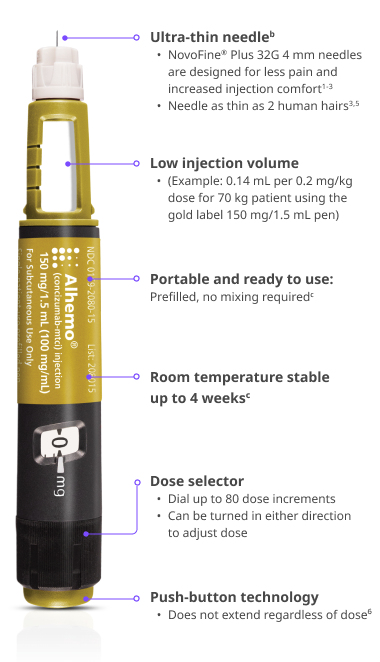
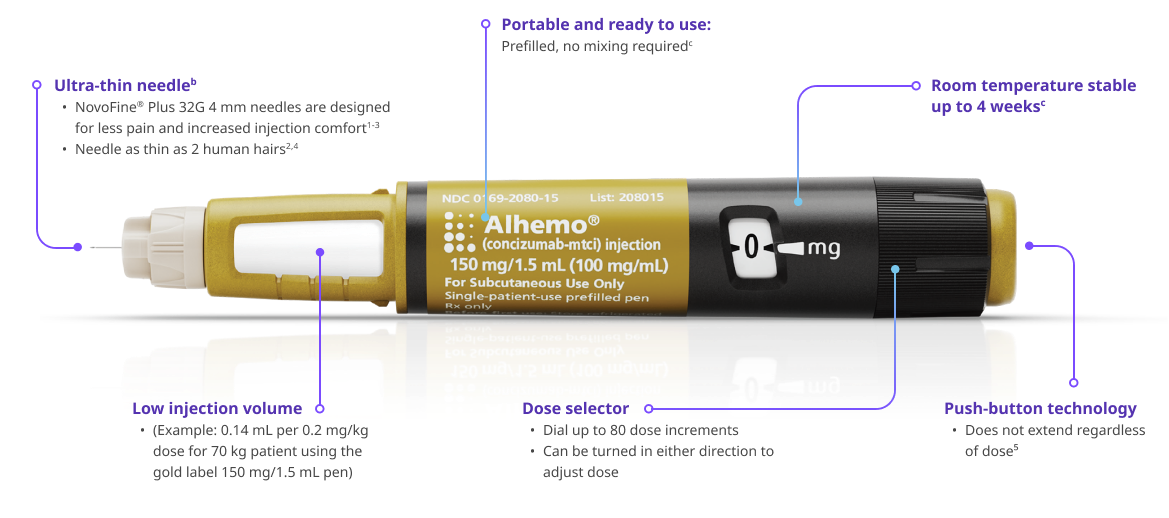

No IV infusions2
No IV infusions

No mixing2
No mixing

No vials2
No vials

No refrigeration required1,d
(up to 4 weeks after first use)
No refrigeration requiredc
(up to 4 weeks after first use)
No IV infusions
No IV infusions

No mixing
No mixing

No vials
No vials

No refrigeration requiredc
(up to 4 weeks after first use)
No refrigeration requiredc
(up to 4 weeks after first use)
aAlhemo® is intended for use under the guidance of a healthcare provider, and may be self-administered or administered by a caregiver after appropriate training and reading the Instructions for Use, if a healthcare provider determines that is appropriate.
bNeedles sold separately and may require a prescription in some states. New needle is required for each injection.
cStore in refrigerator before first use. After first use, Alhemo® can be stored at room temperature below 86 ℉ (30 ℃) or in a refrigerator at 36 ℉ to 46 ℉ (2 ℃ to 8 ℃) for up to 4 weeks.
Please see Prescribing Information for full storage information.
IV=intravenous.

“Because it is prefilled and doesn’t need mixing, the Alhemo® pen is ready when I need it."
—Royal lives with hemophilia B with inhibitors, uses Alhemo®, and is an employee of Novo Nordisk.
The Alhemo® pen is easy to use—and easy to learn to use1,6,e
A usability study of patients and caregivers who used the Alhemo® pen-injector found that4:
98%
rated the pen easy to
use (n=78)


97%
rated the pen easy to
learn to use (n=78)


99%
rated it easy to store the
pen (n=76)
Easy=easy or very easy.
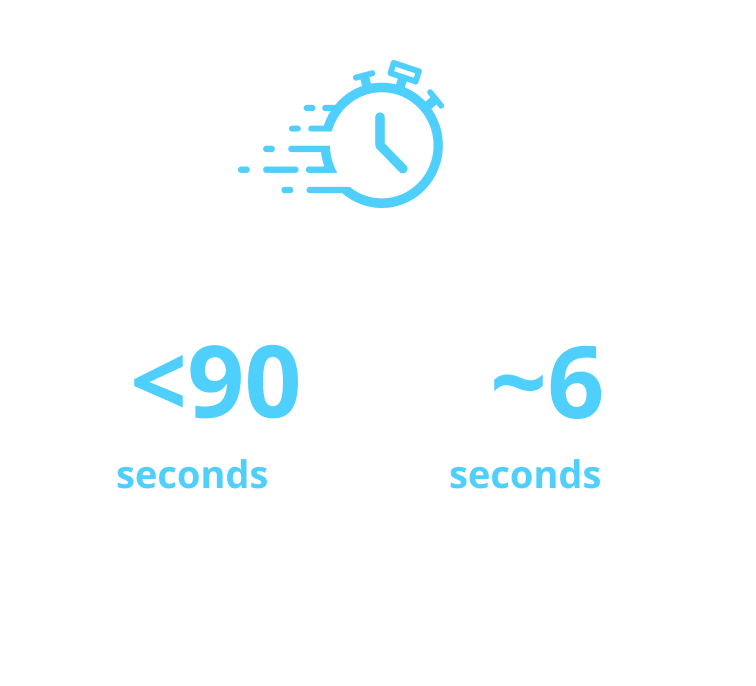

Read IFU for full administration instructions
eAlhemo® is intended for use under the guidance of a healthcare provider, and may be self-administered or administered by a caregiver after appropriate training and reading the Instructions for Use, if a healthcare provider determines that is appropriate.
fAfter the dose counter is at “0,” count slowly to 6 while the needle is still in skin.
FVIII=Factor VIII; IFU=Instructions for Use.
Study design: A device handling study of the Alhemo® pen that included 80 participants: 65 patients (44 adults, 21 adolescents) with hemophilia A or B, with or without inhibitors, using factor replacement or FVIII mimetic therapy (51% on factor, 49% on FVIII mimetic), and 15 caregivers. The main objectives were to determine whether the concizumab pen-injector is easy to learn how to use and easy to use using the Hemophilia Device Handling and Preference Assessment questionnaire. After training, participants independently prepared and performed a single pen injection, administering into an injection pad or manikin. An injection was complete if participant could attach needle, remove outer and inner caps, and set and inject intended dose. Time for training, preparation, injections, and number of complete injections were assessed. Average time to complete an injection was 1 min 21s. Survey rating scale included: Very difficult, Difficult, Neither difficult nor easy, Easy, and Very easy. Limitations: simulated use models may not completely reflect experience of at-home use. In addition, it may be difficult for a participant to evaluate the pen-injector based on a single simulated injection.
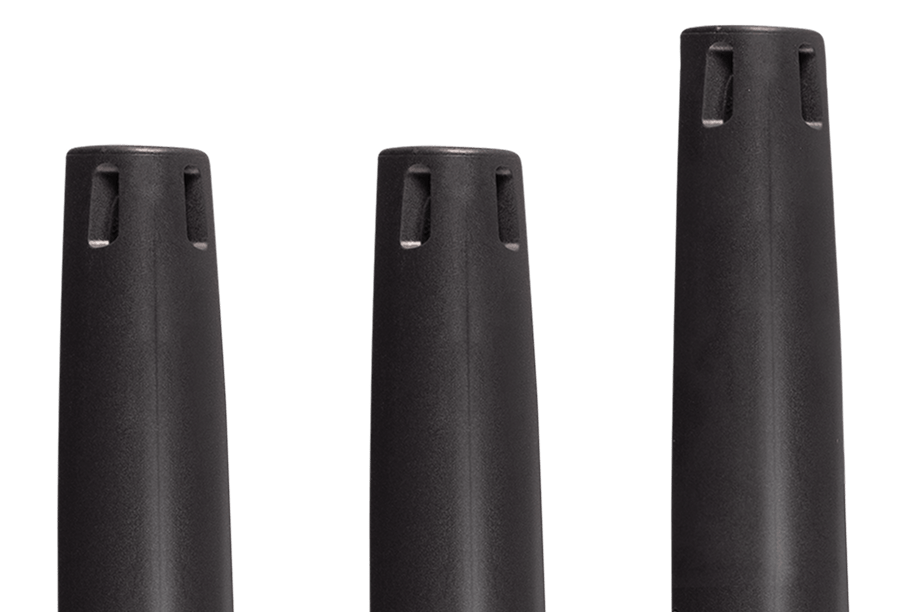

Study design: The device handling study of the Alhemo® pen included 80 participants (65 patients with HA/HB/HwI and 15 caregivers) with 51% on factor replacement or on FVIII mimetic therapy. The main objective was to determine whether the concizumab pen injector is easy to learn how to use and easy to use via training and a simulated injection (administered into an injection pad or manikin) using the Hemophilia Device Handling and Reference Assessment Questionnaire. Injection was complete if participant could attach the needle, remove outer and inner caps, set and inject intended dose. Training time, preparation, and injection completion were assessed. Survey rating scale included: Very difficult, difficult, neither difficult nor easy, easy, and very easy. Limitations include simulated use models and may not fully reflect at-home experience and evaluations based on 1 injection only.
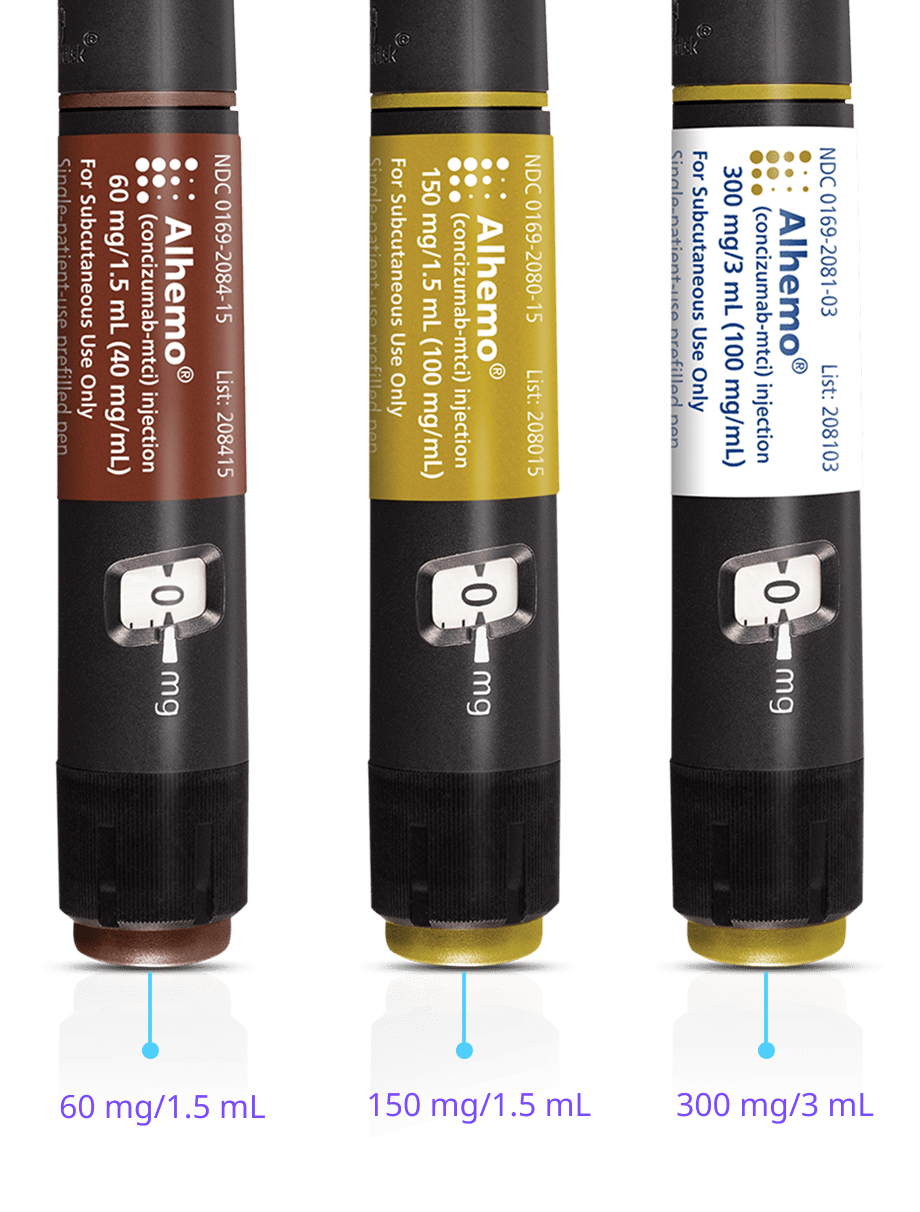

Three pen options1
Each pen-injector contains multiple doses of Alhemo®1
1 pen (150 mg/1.5 mL) has about 10 days of daily Alhemo® treatment: 10 days of 0.2 mg/kg daily maintenance treatment for a patient weighing 154 lb (70 kg)
Review Alhemo® safety
Two studies evaluated Alhemo®, explorer7 and explorer8.
Bleed prevention for hemophilia with or without inhibitors
Patients deserve powerful bleed protection.1
Important Safety Information for Alhemo®
Contraindications
- Alhemo® is contraindicated in patients with a history of known serious hypersensitivity to Alhemo® or its ingredients
Warnings and Precautions
- Thromboembolic Events (TEs): Venous and arterial TEs were reported in 1.9% of patients (6/320) who also had multiple risk factors, including the use of high doses or prolonged treatment with factor product or bypassing agent (2 of 6 patients). Risk factors for TEs may also include conditions in which tissue factor is overexpressed (eg, atherosclerotic disease, crush injury, cancer, disseminated intravascular coagulation, thrombotic microangiopathy, or septicemia). Inform patients about and monitor them for signs and symptoms of TEs. In case of suspicion of TEs, discontinue Alhemo® and initiate further investigations and management strategies
- Hypersensitivity Reactions: Alhemo® is contraindicated in patients with a history of known serious hypersensitivity to Alhemo® or its ingredients. Hypersensitivity reactions, including erythema, rash, pruritus, and abdominal pain, have occurred in patients treated with Alhemo®. One patient (<1%) experienced anaphylaxis, which resolved after treatment with antihistamines and corticosteroids. Instruct patients of the signs of acute hypersensitivity reactions and to contact their healthcare provider for mild reactions and to seek urgent medical attention for moderate to severe reactions. Discontinue Alhemo® if severe hypersensitivity symptoms occur and initiate medical management
- Increased Laboratory Values of Fibrin D-dimer and Prothrombin Fragment 1.2: Increased levels of fibrin D-dimer and prothrombin fragment 1.2 were seen in 29 (9.1%) and 26 (8.1%) patients, respectively, which is positively correlated with the plasma concentration of concizumab-mtci, indicating a hemostatic effect. For patients taking Alhemo®, these coagulation biomarkers may not be reliable predictive markers for clinical decision-making with suspicion of thrombosis, such as deep vein thrombosis and pulmonary embolism
Adverse Reactions
- The most frequently reported adverse reactions (≥5%) were injection site reactions, headache, and urticaria
- Serious adverse reactions were reported in 6.1% of patients with inhibitors who received Alhemo®. Permanent discontinuation of Alhemo® occurred in 1 patient due to a renal infarct and dosage interruptions of Alhemo® occurred in 1 patient (3%) and was a hypersensitivity reaction
Drug Interactions
- Breakthrough Bleeding Treatment: Take appropriate precautions when treating breakthrough bleeding events in patients receiving Alhemo® prophylaxis and FVIII or FIX or a bypassing agent (eg, rFVIIa or aPCC). For mild and moderate bleeds, the lowest approved dose in the approved product labeling is recommended. For aPCC, a maximum dose of 100 units/kg within 24 hours is recommended. For severe bleeds, follow the dosing instructions in the approved labeling based on clinical judgment
Please click here for Alhemo® Prescribing Information.
Indications and Usage
Alhemo® (concizumab-mtci) injection 60 mg, 150 mg, or 300 mg is indicated for routine prophylaxis to prevent or reduce the frequency of bleeding episodes in adult and pediatric patients 12 years of age and older with hemophilia A or B with or without Factor VIII or IX inhibitors.
Important Safety Information for Alhemo®
Contraindications
- Alhemo® is contraindicated in patients with a history of known serious hypersensitivity to Alhemo® or its ingredients
Warnings and Precautions
- Thromboembolic Events (TEs): Venous and arterial TEs were reported in 1.9% of patients (6/320) who also had multiple risk factors, including the use of high doses or prolonged treatment with factor product or bypassing agent (2 of 6 patients). Risk factors for TEs may also include conditions in which tissue factor is overexpressed (eg, atherosclerotic disease, crush injury, cancer, disseminated intravascular coagulation, thrombotic microangiopathy, or septicemia). Inform patients about and monitor them for signs and symptoms of TEs. In case of suspicion of TEs, discontinue Alhemo® and initiate further investigations and management strategies
- Hypersensitivity Reactions: Alhemo® is contraindicated in patients with a history of known serious hypersensitivity to Alhemo® or its ingredients. Hypersensitivity reactions, including erythema, rash, pruritus, and abdominal pain, have occurred in patients treated with Alhemo®. One patient (<1%) experienced anaphylaxis, which resolved after treatment with antihistamines and corticosteroids. Instruct patients of the signs of acute hypersensitivity reactions and to contact their healthcare provider for mild reactions and to seek urgent medical attention for moderate to severe reactions. Discontinue Alhemo® if severe hypersensitivity symptoms occur and initiate medical management
- Increased Laboratory Values of Fibrin D-dimer and Prothrombin Fragment 1.2: Increased levels of fibrin D-dimer and prothrombin fragment 1.2 were seen in 29 (9.1%) and 26 (8.1%) patients, respectively, which is positively correlated with the plasma concentration of concizumab-mtci, indicating a hemostatic effect. For patients taking Alhemo®, these coagulation biomarkers may not be reliable predictive markers for clinical decision-making with suspicion of thrombosis, such as deep vein thrombosis and pulmonary embolism
Adverse Reactions
- The most frequently reported adverse reactions (≥5%) were injection site reactions, headache, and urticaria
- Serious adverse reactions were reported in 6.1% of patients with inhibitors who received Alhemo®. Permanent discontinuation of Alhemo® occurred in 1 patient due to a renal infarct and dosage interruptions of Alhemo® occurred in 1 patient (3%) and was a hypersensitivity reaction
Drug Interactions
- Breakthrough Bleeding Treatment: Take appropriate precautions when treating breakthrough bleeding events in patients receiving Alhemo® prophylaxis and FVIII or FIX or a bypassing agent (eg, rFVIIa or aPCC). For mild and moderate bleeds, the lowest approved dose in the approved product labeling is recommended. For aPCC, a maximum dose of 100 units/kg within 24 hours is recommended. For severe bleeds, follow the dosing instructions in the approved labeling based on clinical judgment
Please click here for Alhemo® Prescribing Information.
Indications and Usage
Alhemo® (concizumab-mtci) injection 60 mg, 150 mg, or 300 mg is indicated for routine prophylaxis to prevent or reduce the frequency of bleeding episodes in adult and pediatric patients 12 years of age and older with hemophilia A or B with or without Factor VIII or IX inhibitors.
References:
- Alhemo [package insert]. Plainsboro, NJ; Novo Nordisk Inc.
- Data on file. Novo Nordisk Inc; Plainsboro, NJ.
- NovoFine® Plus 32G. Package label. Novo Nordisk Inc.
- Arendt-Nielsen L, Egekvist H, Bjerring P. Pain following controlled cutaneous insertion of needles with different diameters. Somatosens Mot Res. 2006;23(1-2):37-43.
- Hall AB, Saferstein R. Forensic Science Handbook. Volume I. 3rd ed. Pearson; 2020.
- Novo Nordisk A/S. OUR PRODUCTS FlexTouch®. Novo Nordisk. 2025. Accessed May 9, 2025. https://www.novonordisk.com/our-products/pens-and-needles/flextouch.htm
- Rasmussen NK, Berg B, Christiansen ASL, et al. The concizumab pen-injector is easy to use and preferred by hemophilia patients and caregivers: a usability study assessing pen-injector handling and preference. Patient Prefer Adherence. 2024:18 1713-1727.
